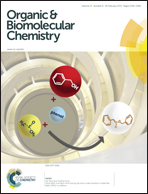Synthesis, binding affinity and structure–activity relationships of novel, selective and dual targeting CCR2 and CCR5 receptor antagonists†
Abstract
CCR2 and CCR5 receptors play a key role in the development and progression of several inflammatory, cardiovascular and autoimmune diseases. Therefore, dual targeting of both receptors appeals as a promising strategy for the treatment of such complex, multifactorial disorders. Herein we report on the design, synthesis and biological evaluation of benzo[7]annulene- and [7]annulenothiophene-based selective and dual CCR2 and CCR5 receptor antagonists. Intermediates were designed in such a way that diversification could be introduced at the end of the synthesis. Starting from the lead compound TAK-779 (1), the quaternary ammonium moiety was exchanged by different non-charged moieties, the 4-methylphenyl moiety was extensively modified and the benzo[7]annulene core was replaced bioisosterically by the [7]annulenothiophene system. The naphthyl derivative 9h represents the most promising dual antagonist (Ki (CCR2) = 25 nM, IC50 (CCR5) = 17 nM), whereas the 6-isopropoxy-3-pyridyl and 4-methoxycarbonylphenyl derivatives 9k and 9r show more than 20-fold selectivity for the CCR2 (Ki = 19 nM) over the CCR5 receptor.


 Please wait while we load your content...
Please wait while we load your content...